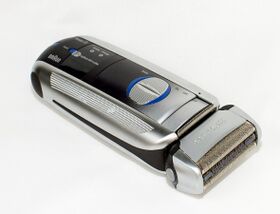Engineering:Electric razor
 Rotary-style electric razor | |
Foil-type electric razor | |
| Other names | Dry razor, electric shaver, shaver |
|---|---|
| Classification | Personal grooming device |
| Types | Rotary, foil, corded, battery-powered |
| Related | Electric hair clippers, safety razor |
The electric razor (also known as the dry razor, electric shaver, or simply shaver) is a razor with a rotating or oscillating blade. The electric razor usually does not require the use of shaving cream, soap, or water. The razor may be powered by a small DC motor, which is either powered by batteries or mains electricity. Many modern ones are powered using rechargeable batteries. Alternatively, an electro-mechanical oscillator driven by an AC-energized solenoid may be used. Some very early mechanical shavers had no electric motor and had to be powered by hand, for example by pulling a cord to drive a flywheel.
Electric shavers fall into two main categories: foil or rotary-style. Users tend to prefer one or the other. Most rotary-style shavers are cordless—they are charged up with a plug charger or they are placed within a cleaning and charging unit.
History
The first person to receive a patent for a razor powered by electricity was John F. O'Rouke with his US patent 616554 filed in 1898.[1][2] The first working electric razor was invented in 1915 by German engineer Johann Bruecker[3]. Others followed suit, such as the American manufacturer Col. Jacob Schick who patented their first electric razor in 1930.[4][5] The Remington Rand Corporation developed the electric razor further, first producing the electric razor[citation needed] in 1937. Another important inventor was Prof. Alexandre Horowitz, from Philips Laboratories in the Netherlands, who invented the concept of the revolving (rotary) electric razor. It has a shaving head consisting of cutters that cut off the hair entering the head of the razor at skin level.[6][7] Roland Ullmann from Braun in Germany was another inventor who was decisive for development of the modern electric razor.[8] He was the first to fuse rubber and metal elements on shavers[9] and developed more than 100 electrical razors for Braun.[10] In the course of his career Ullmann filed well over 100 patents for innovations in the context of dryshavers.[11] The major manufacturers introduce new improvements to the haircutting mechanism of their products every few years. Each manufacturer sells several different generations of cutting mechanism at the same time, and for each generation, several models with different features and accessories to reach various price points. The improvements to the cutting mechanisms tend to 'trickle-down' to lower priced models over time.
Early versions of electric razors were meant to be used on dry skin only. Many recent electric razors have been designed to allow for wet/dry use, which also allows them to be cleaned using running water or an included cleaning machine, reducing cleaning effort. Some patience is necessary when starting to use a razor of this type, as the skin usually takes some time to adjust to the way that the electric razor lifts and cuts the hairs. Moisturizers designed specifically for electric shaving are available.
Battery-powered electric razors
Since at least the mid-1960s,[12] battery-operated electric razors have been available using rechargeable batteries sealed inside the razor's case, previously nickel cadmium or, more recently, nickel metal hydride. Some modern shavers use Lithium-ion batteries that do not suffer from memory effect. Sealed battery shavers either have built-in or external charging devices. Some shavers may be designed to plug directly into a wall outlet with a swing-out or pop-up plug, or have a detachable AC cord. Other shavers have recharging base units that plug into an AC outlet and provide DC power at the base contacts (eliminating the need for the AC-to-DC converter to be inside the razor, reducing the risk of electric shock).
Razor vs Trimmer
An electric razor and an electric trimmer are essentially the same devices by build. But the major difference between the both comes in terms of their usage and the blades that they come with.
Electric razors are made for specifically for providing a clean shave. It has lesser battery power but more aggression towards clipping hair. Electric Trimmers on the other hand are not meant for clean shaves. They come with special combs fixed onto them that aid in proper grooming and trimming of the beard stubs to desired shapes and sizes.[13]
General
Some models, generally marketed as "travel razors" (or "travel shavers"), use removable rechargeable or disposable batteries, usually size AA or AAA. This offers the option of purchasing batteries while traveling instead of carrying a charging device. The design of some electric shavers has been criticised for their protruding cutting design as being conducive to hair loss.[14]
References
- ↑ Waits, Robert K. (2013). Before Gillette: The Quest for a Safe Razor - Inventors and Patents 1762-1901. Lulu.com. ISBN 9781257216024.
- ↑ U.S. Patent 616,554
- ↑ ABC der Deutschen Erfindungen. Reportage von Dorothee Ott und Kristine von Soden. Hessischer Rundfunk, 23. Dezember 2010.
- ↑ "Jacob Schick Invents the Electric Razor". May 13, 2017. https://connecticuthistory.org/jacob-schick-invents-the-electric-razor/.
- ↑ U.S. Patent 1,757,978
- ↑ DE patent 694507 "Haarschergeraet"
- ↑ CA patent 401667 "HAIR CUTTING DEVICE"
- ↑ "A History of Braun Design, Part 1: Electric Shavers - Core77" (in en). http://www.core77.com/posts/24437/a-history-of-braun-design-part-1-electric-shavers-24437.
- ↑ Terstiege, Gerrit, ed (2009). The making of design: from the first model to the final product. Basel: Birkhäuser. ISBN 9781299719897. OCLC 852656502.
- ↑ GmbH, Frankfurter Allgemeine Zeitung (2010-12-27). "Braun-Ausstellung: Elektrisch und trocken gegen 15.000 Barthaare". http://www.faz.net/1.1086648.
- ↑ "Google Scholar". https://scholar.google.ch/scholar?hl=en&as_sdt=0,5&q=%22roland+ullmann%22+patent&btnG=.
- ↑ Electric Shaver Museum. Pedewei.home.xs4all.nl. Retrieved on 2012-09-14.
- ↑ "How to clean and maintain an Electric Shaver" (in en-US). 2019-10-03. https://homezene.com/electric-shaver-maintenance/.
- ↑ Sadick, Neil (1991). Your hair : helping to keep it : treatment and prevention of hair loss for men and women. Yonkers, N.Y: Consumer Reports Books. ISBN 0890434506. https://archive.org/details/yourhairhelpingt00sadi/page/79.



